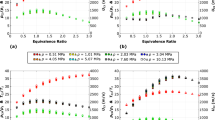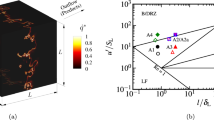Abstract
A model of nonequilibrium gas dynamics is proposed to describe ignition and combustion of a mixture of silane, hydrogen, oxygen, and an inert gas (nitrogen or argon). The model is based on detailed chemical kinetics of nonequilibrium chemical reactions. The model adequately describes the behavior of experimental data on the ignition delay time for this mixture versus the temperature behind the reflected shock wave in accordance with three criteria of ignition. The detonation wave velocity and equilibrium parameters of the mixture (pressure and temperature) are calculated as functions of the fuel–oxidizer equivalence ratio. Based on the dependences of the ignition delay time on the temperature behind the reflected shock wave calculated by this model, an approximation formula for the silane–oxygen–nitrogen/argon is derived.
Similar content being viewed by others
References
J. A. Britten, J. Tong, and C. K. Westbrook, “A Numerical Study of Silane Combustion,” in Proc. Twenty-Third Symp. (Int.) on Combustion (The Combustion Institute, Pittsburgh, 1990), pp. 195–202.
S. Kondo, K. Tokuhashi, A. Takahashi, and M. Kaise, “A Numerical Study of Low Temperature Silane Combustion,” Combust. Sci. Technol. 159, 391–406 (2000).
T. A. Miller, M. S. Wooldridge, and J. W. Bozzelli, “Computational Modeling of the SiH3 + O2 Reaction and Silane Combustion,” Combust. Flame 137, 73–92 (2004).
NIST Chemistry WebBook; http://webbook.nist.gov/.
L. K. Rutz and H. Bockhorn, “Theoretical Study of the Structure, Properties and Formation of SiO2 Clusters,” in Proc. of the European Combustion Meeting, 2007, pp. 1–4.
A. G. McLain, C. J. Jachimowski, and R. C. Rogers, “Ignition of SiH4–H2–O2–N2 behind Reflected Shock Waves,” NASA Technical Paper No. 2114 (1983).
E. L. Petersen and M. W. Crofton, “Ignition and Oxydation of Dilute Silane-Oxydizer Mixtures behind Reflected Shock Waves,” AIAA Conf. Paper No. 2002-3875 (2002).
A. V. Fedorov, P. A. Fomin, and D. A. Tropin, “Simple Kinetics and Detonation Wave Structure in a Methane–Air Mixture,” Fiz. Goreniya Vzryva 50 (1), 97–106 (2014)
A. V. Fedorov, P. A. Fomin, and D. A. Tropin, Combust., Expl., Shock Waves 50 (1), 87–96 (2014).
P. A. Fomin, A. V. Fedorov, and J.-R. Chen, “Control of Parameters of the Explosion of a Silane–Air Gas Mixture by Means of Adding Chemically Inert Particles,” in Dynamics of Multiphase Media, Proc. XIII All-Russia Workshop, Novosibirsk, October 8–10, 2013, pp. 161–163.
Author information
Authors and Affiliations
Corresponding author
Additional information
Original Russian Text © D.A. Tropin, A.V. Fedorov.
Published in Fizika Goreniya i Vzryva, Vol. 51, No. 4, pp. 37–45, July–August, 2015.
Rights and permissions
About this article
Cite this article
Tropin, D.A., Fedorov, A.V. Physicomathematical modeling of ignition and combustion of silane in transient and reflected shock waves. Combust Explos Shock Waves 51, 431–438 (2015). https://doi.org/10.1134/S001050821504005X
Received:
Published:
Issue Date:
DOI: https://doi.org/10.1134/S001050821504005X




